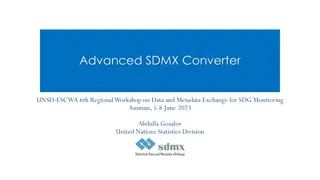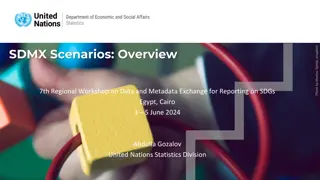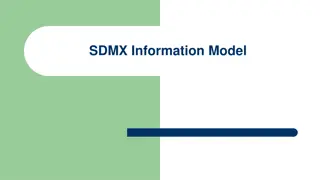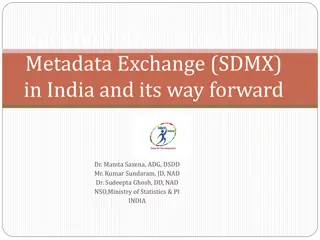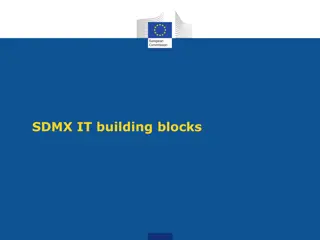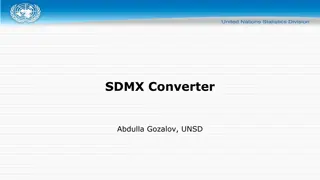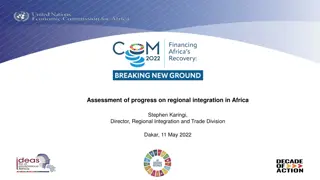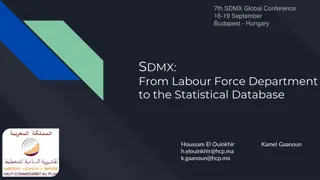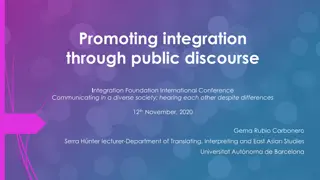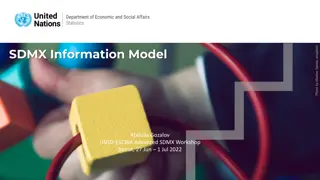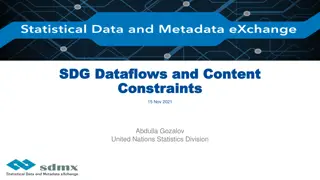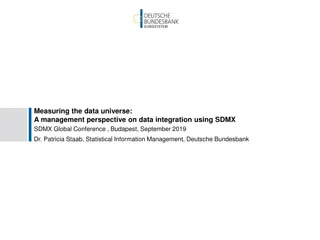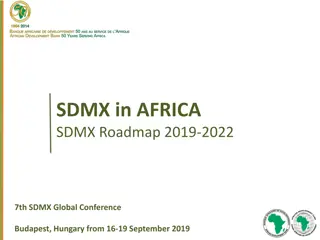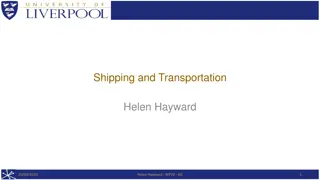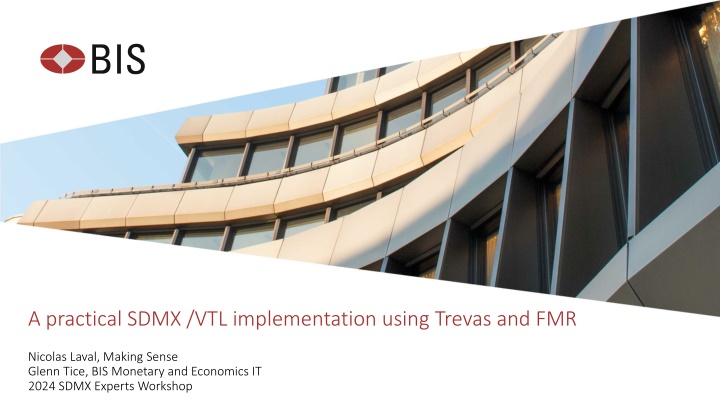
Practical Implementation of VTL Integration with SDMX Using Trevas and FMR
This article explores the practical implementation of integrating VTL with SDMX using tools like Trevas and FMR. It discusses how VTL programs can be stored, exchanged, and referenced within SDMX structures, emphasizing efficient retrieval of data and validation rules. The focus is on the storage, exchange, and referencing of VTL in the context of the SDMX framework, showcasing how FMR supports these processes.
Download Presentation

Please find below an Image/Link to download the presentation.
The content on the website is provided AS IS for your information and personal use only. It may not be sold, licensed, or shared on other websites without obtaining consent from the author. If you encounter any issues during the download, it is possible that the publisher has removed the file from their server.
You are allowed to download the files provided on this website for personal or commercial use, subject to the condition that they are used lawfully. All files are the property of their respective owners.
The content on the website is provided AS IS for your information and personal use only. It may not be sold, licensed, or shared on other websites without obtaining consent from the author.
E N D
Presentation Transcript
Restricted A practical SDMX /VTL implementation using Trevas and FMR Nicolas Laval, Making Sense Glenn Tice, BIS Monetary and Economics IT 2024 SDMX Experts Workshop
Restricted VTL integration with SDMX VTL has its own information model based on GSIM, but is designed to be compatible with SDMX and other standards like DDI The SDMX Section 6 Technical Notes explains how VTL and SDMX work together Two important elements for a practical implementation: How VTL programs can be stored and exchanged together with the SDMX structures of the datasets involved How SDMX artefacts can be referenced in VTL code as inputs and / or outputs of Transformations and for validation Rules 2
Restricted Storage and exchange of VTL In the SDMX context, VTL code is managed as structural metadata The SDMX information model provides several artefacts for this purpose Centres on the Transformation Scheme artefact which encapsulates a VTL program Allows VTL to be stored and exchanged in the same way as other SDMX structures 3
Restricted Referencing SDMX artefacts in VTL Statements and Rules SDMX artefacts can be referenced in VTL code using full or partial URNs DS_r := urn:sdmx:org.sdmx.infomodel.datastructure.Dataflow=ECB:EXR(1.0) / 10 define datapoint ruleset DPR_1 (valuedomain SDMX:CL_AREA(2.0) as A, IMF:CL_CURRENCY(1.6) as B) when expression then end datapoint ruleset Or, by user defined aliases - defined using VTL Mapping Schemes which allow SDMX artefacts to be given symbolic names DS_r := EXCHANGE_RATES / 10 4
Restricted FMR support for storage and exchange of VTL All VTL structures supported in FMR 11 VTL syntax checking on structure submission Basic authoring and maintenance using the FMR web user interface Better VTL code development environments can interface to the FMR repo by the REST API 5
Restricted FMR support for referencing SDMX artefacts in VTL code Deep structure cross referencing FMR identifies SDMX artefacts referenced by full or partial URN in the VTL code Manages them as structural metadata cross references Why? SDMX-aware VTL execution engines can efficiently retrieve both the VTL program and structural metadata for input datasets and validation rules in a single REST web service call for the Transformation Scheme with references=descendants Enforces metadata referential integrity 6
Restricted SDMX VTL artefacts deep structure cross referencing Example A Transformation Scheme has a single Transformation DS_r <- ECB:EXR(1.0) / 10 On submission of the Transformation Scheme to the metadata registry, FMR will: Syntactically analyse the VTL code Identify ECB:EXR(1.0) as an SDMX partial URN Infer that it is a Dataflow from the code context Verify that the Dataflow exists in the registry Create a cross reference to the Dataflow from the Transformation Scheme Store the Transformation Scheme 7
Restricted Executing a VTL program using Trevas and FMR in practice FMR SDMX REST API Response - SDMX structure message - Transformation Scheme the VTL program - Just the necessary structural metadata SDMX structure query - Transformation Scheme by ID - references = descendants Trevas VTL execution engine Output dataset(s) Input dataset(s) Example structure query: https://registry.my.org/sdmx/v2/structure/transformationscheme/all/MY_VTL_TRANS/+/?references=descendants 8
Restricted The Trevas VTL engine Nicolas Laval 9


